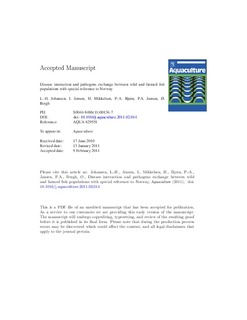Disease interaction and pathogens exchange between wild and farmed fish populations with special reference to Norway
Johansen, Lill-Heidi; Jensen, Ingvill; Mikkelsen, Helene; Bjørn, Pål Arne; Jansen, P.A.; Bergh, Øivind
Journal article, Peer reviewed
Permanent lenke
http://hdl.handle.net/11250/117164Utgivelsesdato
2011-05-21Metadata
Vis full innførselSamlinger
Originalversjon
http://dx.doi.org/10.1016/j.aquaculture.2011.02.014Sammendrag
Norway has the largest salmon-farming industry in the world, an industry that is still growing, and in recent years production of marine species like Atlantic cod has also increased. At the same time, Norway has the world's largest wild stock of Atlantic salmon and has fjord systems and ocean areas rich in wild marine fish species which form the basis of a large fishing industry. As the aquaculture industry grows and diversifies, there is concern about the potential effects of pathogens spreading from farmed fish to wild populations. The overall health situation in Norwegian aquaculture is good, but some pathogens are not controlled effectively. In particular, salmon lice produced in farms may cause problems for wild salmonids and other parasites may be abundant too. Also, viral diseases in Atlantic salmon and bacterial diseases in Atlantic cod give rise to several disease outbreaks annually. The open design of most aquaculture systems allows the transmission of pathogens from the environment or from wild fish to the farmed fish. The objective of this review is to provide an overview of current knowledge of disease interaction and pathogen exchange between farmed and wild fish populations, with emphasis on Norwegian condition. In addition, the paper contains an evaluation of research methods that would be useful in expanding knowledge of pathogen exchange between wild and farmed fish, and in surveys of diseases in wild fish populations. The impact of pathogen transfer from farmed fish to economically important wild fish populations is assessed together with risk analysis considering possible consequences of pathogen exchange between farmed and wild fish. Finally, the review contains suggestions for future research that will increase the knowledge in the field.
